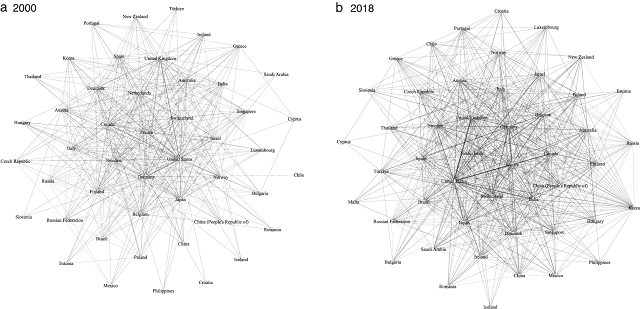
The interconnected world of today’s economy is driven by complex networks. Two of these networks, Global Value Chains (GVCs) and Global Innovation Networks (GINs), play a crucial role in international trade and technological advancement.
Researchers at Zhejiang Gongshang University (China) constructed a global network of innovation cooperation based on patent cooperation data and then analyzed the impact of different network characteristics on enhancing the state of the global value chain.
Understanding the Networks
GVCs represent the international division of labor across different stages of production. Take a smartphone, for example: its design might be done in one country, parts manufactured in another, and final assembly elsewhere. This interconnected process is a GVC.
GINs, on the other hand, focus on collaboration in innovation. Countries and firms work together to develop new technologies, sharing knowledge and expertise.
The missing link: GINs and GVCs
Surprisingly, the relationship between GINs and GVCs remains underexplored. Some scholars argue that GINs empower countries to move up the GVC ladder. By collaborating with leading innovators, developing economies can access cutting-edge technologies and knowledge, propelling them into higher-value activities within the chain.
However, others argue that GINs may perpetuate inequalities. Developed nations could dominate these networks, capturing most of the benefits of innovation and leaving developing countries stuck in low-value tasks.
Closing the knowledge gap: research agenda
This research dives deep into the GIN-GVC connection, addressing two key questions:
- Impact of GIN integration: Does a country’s participation in a GIN influence its position in GVCs? If so, how?
- Heterogeneity in effects: Do different levels of GIN integration impact GVCs differently in developed, emerging, and developing economies?
To answer these questions, researchers employed a unique approach. They constructed a global innovation network based on patent cooperation data, revealing how countries collaborate on innovation projects. They then used econometric models to analyze how network characteristics (such as centrality, network strength, and structural holes) influence a country’s position in GVCs.
This combined approach offers a more comprehensive understanding of the GIN-GVC relationship than traditional methods.
Key findings
The study reveals a significant connection between a country’s GIN characteristics and its position within GVCs. Here’s what they found:
- Stronger networks, higher status: Countries with GINs characterized by high eigenvector centrality (meaning they collaborate with other well-connected countries) and network connectivity (overall level of collaboration) tend to have a higher status in GVCs. Put simply, being part of an influential and well-connected innovation network boosts a country’s position in the global value chain.
- Double-edged sword of constraint: Interestingly, a high degree of constraint within a GIN (limited collaboration outside a small group) is associated with a lower GVC status. This suggests that relying too heavily on a few innovation partners can hinder a country’s advancement in the global value chain.
Varying impacts
The study also highlights interesting differences in how GINs affect different countries:
- Developed nations: For them, GINs act as a catalyst, accelerating their position within GVCs due to their established innovation infrastructure and resources.
- Emerging economies: The impact is less clear-cut. GINs can be both beneficial and detrimental, depending on specific circumstances.
- Developing countries: The effects of GINs are less pronounced in these countries, suggesting the need for tailored policies to effectively harness these networks for growth.
Implications for policymakers
This research provides valuable insights for governments seeking to boost their country’s position in the global value chain. Here are some key takeaways:
- Promoting technological innovation: Investment in research and development fosters a strong base of national innovation, making a country a more attractive partner within GINs.
- Embracing cross-border collaboration: Encouraging international partnerships in research and development allows countries to leverage others’ expertise and resources, boosting them on the GVC scale.
- Specific policies: Developing and emerging economies need tailored policies to effectively harness GINs. This could involve fostering national innovation ecosystems while strategically selecting international partners.
By understanding the interaction between GINs and GVCs, policymakers can design strategies to enhance their country’s role in the globalized economy. This research paves the way for further exploration of this crucial relationship, shaping a future where innovation networks drive prosperity worldwide.
Conclusion
A country’s integration into a global innovation network significantly impacts its status in global value chains. The characteristics of innovation networks, such as centrality and connectivity, are associated with a higher status in GVCs. Additionally, international collaboration in innovation plays a crucial role in knowledge transfer and technology diffusion, facilitating continuous improvement in GVCs.
In summary, this article provides theoretical and empirical evidence on the relationship between GINs and GVCs, offering a valuable reference for policymaking on cross-border technological cooperation. The findings underscore the importance of international collaboration in innovation for economic development and GVC enhancement, highlighting the need for policies that promote equitable and efficient technological cooperation globally.
The study was funded by Major Program of National Philosophy and Social Science Foundation of China; Major Social Science Foundation of Zhejiang, China, Zhejiang province (Zhejiang Gongshang University- Statistics) and the Collaborative Innovation Center of Statistical Data Engineering Technology & Application.
Contact
Aiting Xu
School of Statistics and Mathematics, Zhejiang Gongshang University
Hangzhou, China
Email: aitingxu@163.com
Reference (open access)
Xu, S., Lian, G., Song, M. et al. Do global innovation networks influence the status of global value chains? Based on a patent cooperation network perspective. Humanit Soc Sci Commun 11, 892 (2024). https://doi.org/10.1057/s41599-024-03413-7
Editor and founder of “Innovar o Morir” (‘Innovate or Die’). Milthon holds a Master’s degree in Science and Innovation Management from the Polytechnic University of Valencia, with postgraduate diplomas in Business Innovation (UPV) and Market-Oriented Innovation Management (UPCH-Universitat Leipzig). He has practical experience in innovation management, having led the Fisheries Innovation Unit of the National Program for Innovation in Fisheries and Aquaculture (PNIPA) and worked as a consultant on open innovation diagnostics and technology watch. He firmly believes in the power of innovation and creativity as drivers of change and development.





